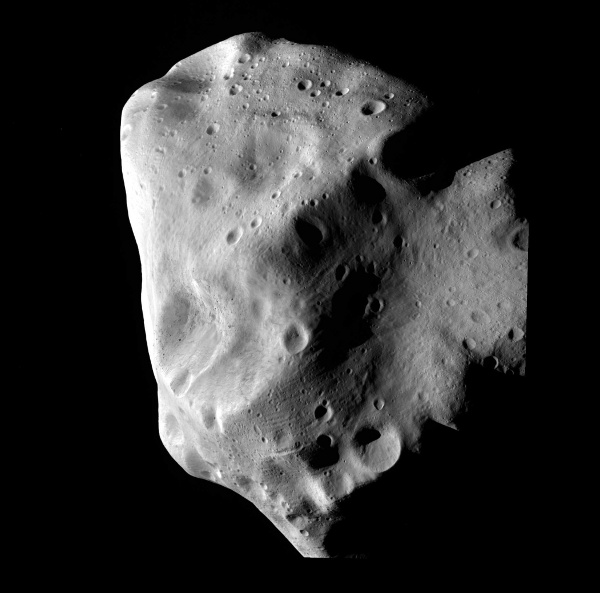Rendezvous with Lutetia
July 13, 2010
The chemical element,
Lutetium, derives its name from Latin name for
Paris, "Lutetia." Lutetia is also the name of an
asteroid that was just visited by the
Rosetta spacecraft of the
European Space Agency. Rosetta was launched on March 2, 2002 by an
Ariane 5G+ rocket, so this asteroid encounter has been more than six years in the making. Lutetia, like other asteroids, resides in orbit between
Mars and
Jupiter. It extends about 80 miles in its longest dimension, and ground observations have indicated that it might be composed of pristine solar system material, making it a
C-type asteroid. There are indications that it might not be pristine, after all. It might be a piece of a larger asteroid that was smashed in a collision. In that case, it would have residual metals on its surface, making it an
M-type asteroid. The Rosetta mission intends to find out.

Lutetia at closest approach by the Rosetta spacecraft
Rosetta's closest approach to Lutetia was about 1,900 miles, and it occurred at 15:44
GMT, Saturday, July 10, 2010. Since the speed of the spacecraft was nearly ten miles a second, the entire encounter occurred in a span of about a minute. About 400 images were taken in this single minute, but they were stored for transmission, since it takes ten minutes to transmit each image back to Earth. Photographs sent by Rosetta's
OSIRIS camera show it to be irregular in shape and marked by some large craters, an appearance much like
other asteroids. The best image resolution is about sixty meters.
Photography wasn't the only thing Rosetta was doing during this encounter. There were further spectroscopic, magnetic and plasma experiments. Instruments were also on board to examine any dust in Lutetia's vicinity.
US President Obama has stated that a worthy goal for
NASA would be to send astronauts to an asteroid in the 2020s. I don't think this will happen. Our on-again, off-again, missions to the
moon and Mars are evidence enough that the US manned space program is dead and unlikely to be resurrected. Tax dollars are poured into fighting endless wars, rather than scientific and technical advancement. The US has resigned itself to second-rate status in everything from
broadband connectivity to
energy-independence.
Rendezvous with Rama is the title of a novel by
Arthur C. Clarke. It's the story about the discovery of Rama, an unoccupied, fifty kilometer alien ship that was initially thought to be an asteroid.
References:
- Rosetta triumphs at asteroid Lutetia, European Space Agency, July 10, 2010.
- Jonathan Amos, "Rosetta probe passes Asteroid Lutetia," July 10, 2010
- Richard Gray, "Space probe has close encounter with giant asteroid," July 10, 2010.
- The Rosetta Spacecraft Page on Wikipedia.
Permanent Link to this article